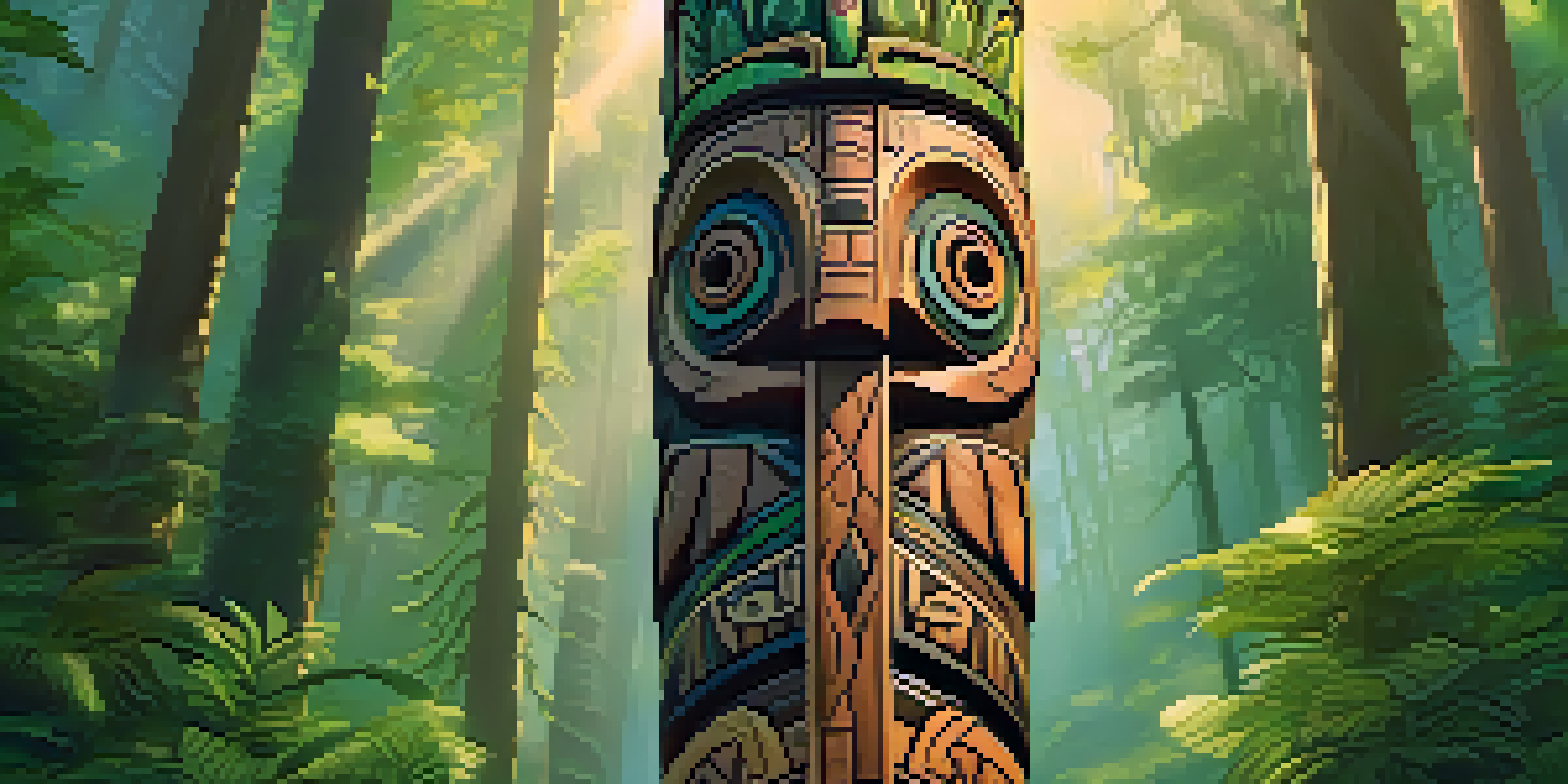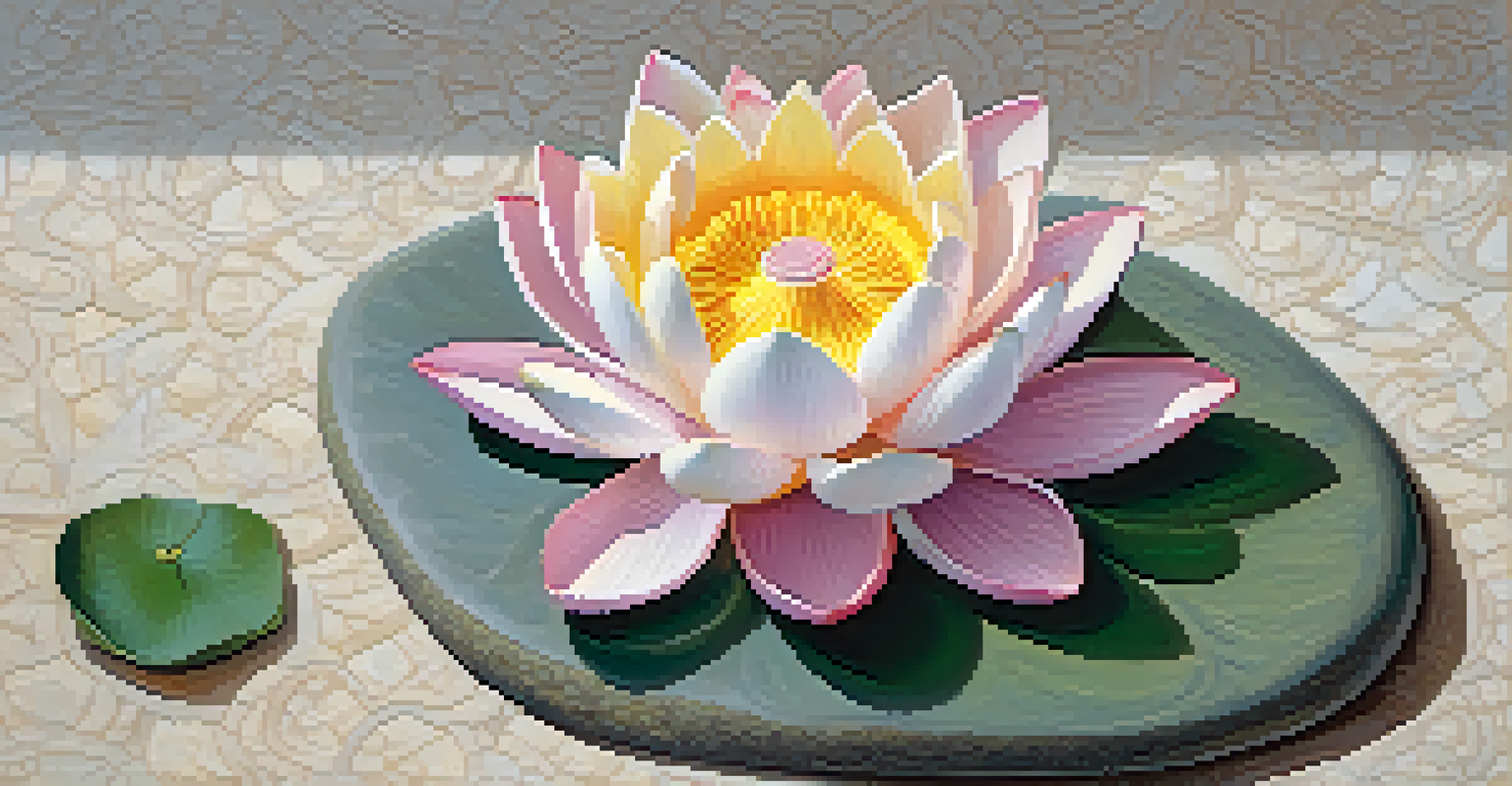Understanding the Significance of Symbols in Carving Arts

The Role of Symbols in Carving Arts Across Cultures
Symbols have played a vital role in the carving arts throughout history, serving as visual language that conveys deeper meanings. Across different cultures, carvings often tell stories or represent beliefs, values, and traditions. For instance, totem poles among Indigenous peoples of North America are rich in symbolism, each figure representing a specific clan or family history.
The artist is not a special kind of person; rather, each person is a special kind of artist.
The significance of these symbols goes beyond mere decoration; they connect the community to its heritage. By understanding the symbols in these artworks, we gain insight into the culture's worldview and practices. This connection fosters a sense of identity and continuity within communities, as the symbols often reflect their experiences and aspirations.
Moreover, symbols in carving arts can transcend geographical boundaries, establishing common themes among diverse cultures. Whether it's the intricate designs of African masks or the serene figures in Asian sculptures, these symbols resonate with universal human experiences, making them powerful tools for communication.
Decoding Common Symbols in Carving Arts
Many carvings feature symbols that are widely recognized, such as the heart, which represents love and compassion. When we see a heart carved into wood or stone, we instantly connect it with emotions and relationships, illustrating how symbols can evoke feelings without words. Similarly, animals in carvings often symbolize various traits—like the lion for courage or the owl for wisdom.

Understanding the meaning behind these symbols allows us to appreciate the artist's intention and the cultural context in which the work was created. For example, in Celtic art, knotwork symbolizes the interconnectedness of life, a theme that resonates deeply with their spiritual beliefs. Such insights enrich our viewing experience, transforming it from mere observation to meaningful engagement.
Symbols Connect Cultures and Heritage
Carving arts utilize symbols to convey cultural beliefs and values, fostering a sense of identity and continuity within communities.
Furthermore, symbols can also evolve over time, adapting to new contexts and interpretations. What was once a simple representation might take on new meaning in a contemporary setting, illustrating how art continuously converses with society. This fluidity keeps the art relevant and allows it to resonate across generations.
The Emotional Impact of Symbolic Carvings
Symbolic carvings can evoke powerful emotions, making them impactful pieces of art. When an artist carves a symbol, they infuse it with personal and cultural significance, which can resonate deeply with viewers. For instance, a carving of a grieving figure might evoke feelings of empathy and sorrow, connecting the observer to the shared experience of loss.
Art is the most beautiful of all lies.
This emotional connection is one of the reasons why carved symbols remain prevalent in memorials and commemorative art, serving as poignant reminders of loved ones or significant events. The symbolism embedded in each carving can transform a simple object into a vessel of memory and reflection, enriching the viewer's experience.
Moreover, the tactile nature of carving invites a physical interaction that can heighten emotional responses. Touching a carved surface can feel like reaching back through time, connecting us to the artist's intention and the culture from which it originates. This rich interplay between emotion and symbolism is what makes carving arts so compelling.
Symbolism in Modern Carving Arts
In contemporary carving arts, artists often leverage traditional symbols while infusing them with modern interpretations. This blend creates a dialogue between the past and present, allowing viewers to see familiar symbols in new light. For example, a modern sculpture might use native motifs to address contemporary social issues, bridging cultural heritage with current narratives.
This evolution of symbolism reflects society's changing values, making modern carving arts a valuable commentary on our times. Artists today challenge viewers to rethink these symbols, pushing them to consider their relevance in today's world. As a result, carvings become not just aesthetic objects but also platforms for discussion and reflection.
Emotional Resonance of Carvings
Symbolic carvings evoke powerful emotions, transforming art into a vessel of memory and reflection for viewers.
Additionally, modern technology has expanded the possibilities for carving, enabling artists to explore new materials and techniques. This innovation allows for a wider range of expressions while still honoring traditional symbolism, fostering a sense of continuity and growth within the art form.
The Spiritual Significance of Symbols in Carvings
Many cultures use symbols in carving arts as a means of expressing spiritual beliefs or practices. For instance, in various Indigenous cultures, carvings often depict spiritual beings or creation stories, serving as a bridge between the physical and metaphysical worlds. These symbols can serve as reminders of sacred teachings and the interconnectedness of all life.
The spiritual significance of these carvings can also be seen in religious art, where symbols convey messages of faith and devotion. For example, the lotus flower in Buddhist carvings represents purity and enlightenment, offering viewers a visual reminder of spiritual aspirations. Such symbols not only enhance the aesthetic appeal but also invite contemplation and reflection on deeper spiritual truths.
Moreover, the act of carving itself can be viewed as a spiritual practice. Many artists approach their work with a sense of reverence, viewing each cut and detail as a way to connect with the divine. This spiritual dimension adds another layer of meaning to the finished piece, inviting viewers to engage on both an emotional and spiritual level.
Preserving Symbolic Carving Traditions
As globalization influences art forms, preserving the symbolic traditions in carving arts becomes increasingly important. Many cultures face the risk of losing their unique symbols and the stories they tell due to modernization and cultural homogenization. Efforts to document and teach these traditions are crucial for maintaining cultural identity and heritage.
Organizations and artisans are working together to ensure that these symbolic carvings are passed down through generations. Workshops, educational programs, and community projects play a vital role in keeping these traditions alive. By fostering an appreciation for the symbolism embedded in these artworks, younger generations can connect with their roots.
Modern Symbols Reflect Contemporary Issues
Contemporary artists blend traditional symbols with modern interpretations, creating a dialogue that addresses current social narratives.
Moreover, the revival of interest in traditional crafts has sparked a renewed appreciation for symbolic carvings. Artists and collectors alike are recognizing the value of these works, not just for their aesthetic qualities but for the stories and meanings they carry. This resurgence not only helps preserve cultural heritage but also enriches the global art scene.
The Future of Symbols in Carving Arts
Looking ahead, the future of symbols in carving arts appears vibrant and dynamic. As artists continue to explore new materials and techniques, they will likely invent fresh symbols that resonate with contemporary audiences. This innovation can lead to exciting dialogues about identity, culture, and the human experience.
Additionally, the integration of technology, such as digital carving or 3D printing, opens up new avenues for expression. Artists can create complex designs that were once unimaginable, expanding the possibilities for symbolic representation. This fusion of tradition and technology can create a rich tapestry of symbols that reflect the complexities of modern life.

Ultimately, the significance of symbols in carving arts will continue to evolve, reflecting changes in society while honoring the past. As we embrace these transformations, we can look forward to a future where carving arts remain a powerful medium for storytelling, connection, and cultural expression.